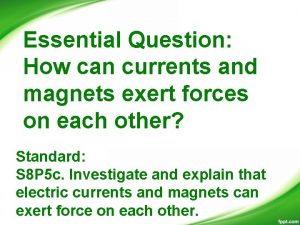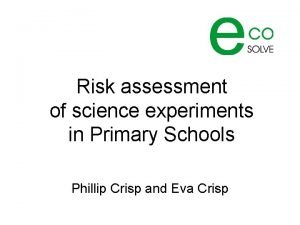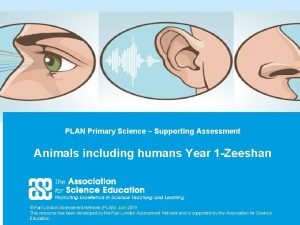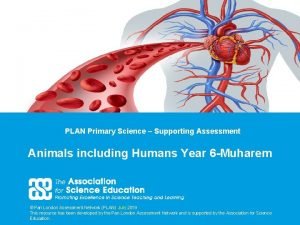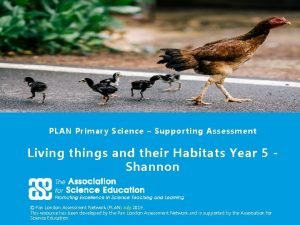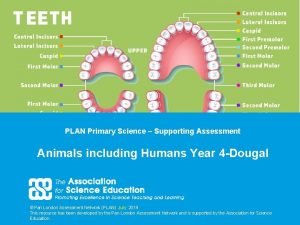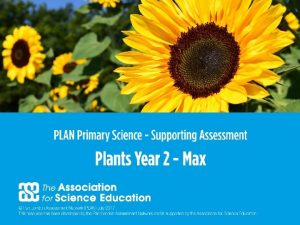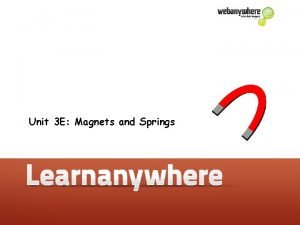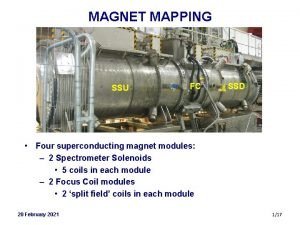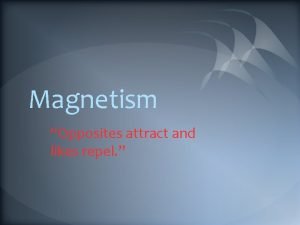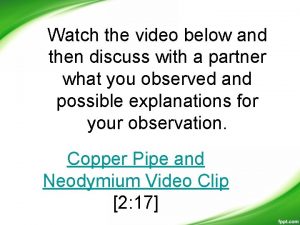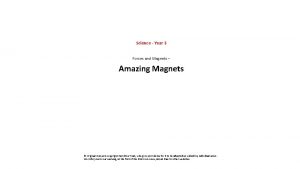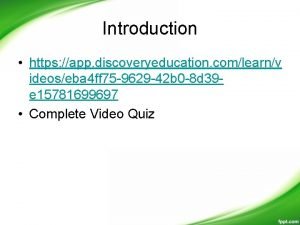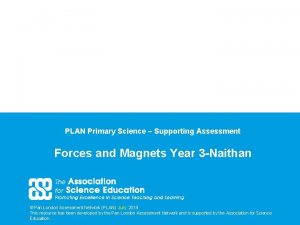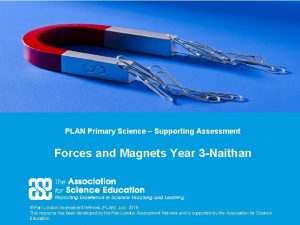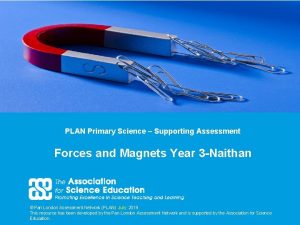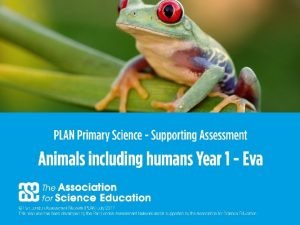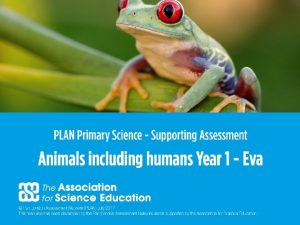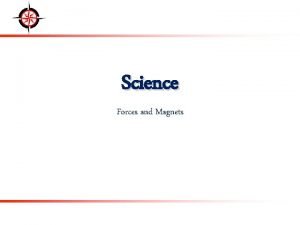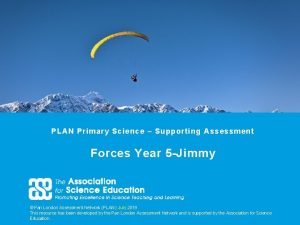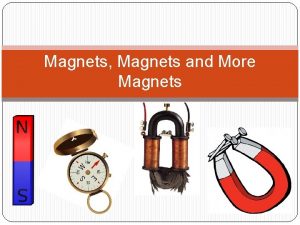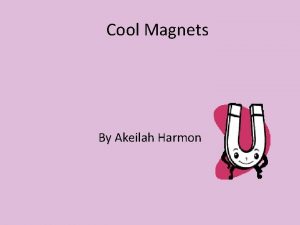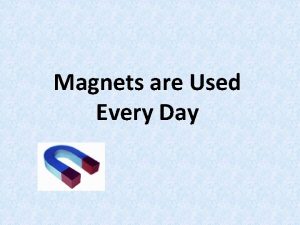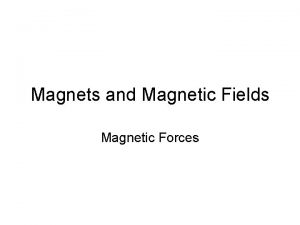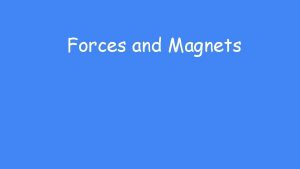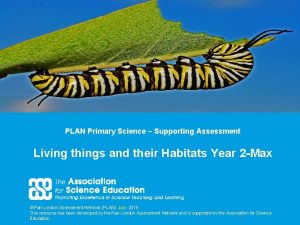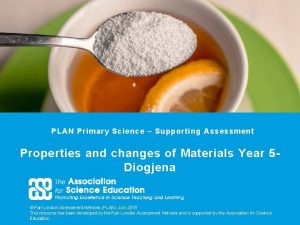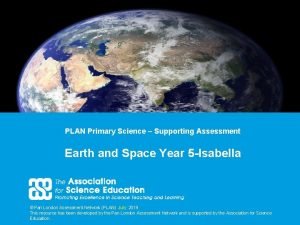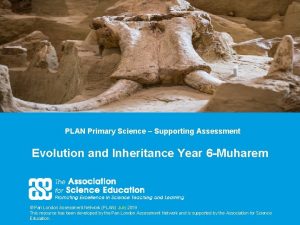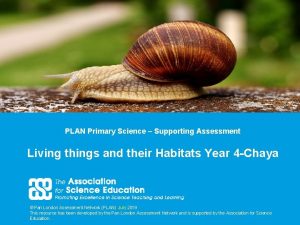PLAN Primary Science Supporting Assessment Forces and Magnets


























- Slides: 26

PLAN Primary Science – Supporting Assessment Forces and Magnets Year 3 - Max © Pan London Assessment Network (PLAN) July 2019 This resource has been developed by the Pan London Assessment Network and is supported by the Association for Science Education. 1

PLAN Primary Science - Supporting Assessment PLAN Primary Science is a set of resources produced to enable teachers to have a clearer understanding of National Curriculum expectations for meeting the standard. Annotated collections of children’s work provide examples of what working at the expected standard for primary science might look like for the knowledge and conceptual understanding statements of the programmes of study (POS). It is not the intention of these resources to specifically exemplify the working scientifically statements. However, aspects of working scientifically have been shown as an integral part of the teaching and learning of the knowledge and concepts. The resources provided have been cross moderated multiple times before publishing so that they can be used with confidence by teachers and subject leaders. Each collection of work shows one example of how a pupil has met National Curriculum statements for a particular area of content but these are not intended to be the definitive way of teaching these statements. 2

Structure of the resources Each resource contains the relevant National Curriculum statements for the unit of work and prior learning, a planning matrix, annotated work and a summary sheet. The matrix provides an interpretation of the key learning of the National Curriculum statements, and suggestions of key vocabulary. In order to be meet the expectations pupils must firstly understand the key concept and then be provided with opportunities to apply that knowledge. This is a key planning tool. Key Learning Secure Possible Evidence Show understanding Overview paragraph describing of a concept by curriculum using scientific vocabulary correctly Key vocabulary – list of words Possible ways to demonstrate key learning, particularly correct usage of vocabulary Apply knowledge in Suggestions of contexts to use. familiar related contexts across a range of enquiry types Possible ways to demonstrate that a pupil has gone beyond recall of facts and can apply the key learning, for example using the vocabulary and basic principles to produce explanations, usually within Working Scientifically contexts. 3

Contents of the materials Please note: The NC statements for each topic area for the relevant year group are stated on the slide. Only the statements in bold on that slide have been exemplified. In these cases the teachers have chosen to split the statements within the topic area to teach at different times. The prior NC statements relevant to the topic area are also stated and use to determine pupils’ knowledge at the start of the unit. Each slide has been annotated with coloured text. Please see key below: Red statements Blue Commentary to explain how evidence meets/does not meet NC Commentary to highlight features of working scientifically Green Pupil Speak Grey Other relevant information eg. vocabulary used 4

Year 2 Statement – Prior learning 2 statements Pupils should be taught to: • find out how the shapes of solid objects made from some materials can be changed by squashing, bending, twisting and stretching (2 -Everyday materials) 5

Year 33 statements Statements Year Pupils should be taught to: • compare how things move on different surfaces (3 -Forces) • notice that some forces need contact between two objects, but magnetic forces can act at a distance (3 -Forces) • observe how magnets attract or repel each other and attract some materials and not others (3 -Forces) • compare and group together a variety of everyday materials on the basis of whether they are attracted to a magnet, and identify some magnetic materials (3 -Forces) • describe magnets as having two poles (3 -Forces) • predict whether two magnets will attract or repel each other, depending on which poles are facing (3 -Forces) 6

Later Statements Pupils do not need to be taught content they will learn in later year groups. They can be challenged by applying the content for their year group in broader contexts. In Year 5 pupils will be taught to: • explain that unsupported objects fall towards the Earth because of the force of gravity acting between the Earth and the falling object (5 -Forces) • identify the effects of air resistance, water resistance and friction, that act between moving surfaces (5 -Forces) • recognise that some mechanisms, including levers, pulleys and gears, allow a smaller force to have a greater effect. (5 Forces) In Key Stage 3 pupils will be taught about: magnetic fields by plotting with compass, representation by field lines Earth’s magnetism, compass and navigation.

Key learning Possible Evidence Shows understanding of a concept using scientific vocabulary correctly A force is a push or a pull. When an object moves on a surface, the texture of the surface and the object affect how it moves. It may help the object to move better or it may hinder its movement e. g. ice skater compared to walking on ice in normal shoes. A magnet attracts magnetic material. Iron and nickel and other materials containing these e. g. stainless steel, are magnetic. The strongest parts of a magnet are the poles. Magnets have two poles – a north pole and a south pole. If two like poles e. g. two north poles, are brought together they will push away from each other – repel. If two unlike poles e. g. a north and south, are brought together they will pull together – attract. For some forces to act there must be contact e. g. a hand opening a door, the wind pushing the trees. Some forces can act at a distance e. g. magnetism. The magnet does not need to touch the object that it attracts. Key vocabulary: Force, push, pull, twist, contact force, non-contact force, magnetic force, magnet, strength, bar magnet, ring magnet, button magnet, horseshoe magnet, attract, repel, magnetic material, metal, iron, steel, poles, north pole, south pole Can give examples of forces in everyday life Can give examples of objects moving differently on different surfaces Can name a range of types of magnets and show the poles attract and repel Can draw diagrams using arrows to show the attraction and repulsion between the poles of magnets Applying knowledge in familiar related contexts, including a range of enquiries Carry out investigations to explore how objects move on different surfaces e. g. spinning tops/coins, rolling balls/cars, clockwork toys, soles of shoes etc. Explore what materials are attracted to a magnet Classify materials according to whether they are magnetic Explore the way that magnets behave in relation to each other Use a marked magnet to find the unmarked poles on other types of magnets Explore how magnets work at a distance e. g. through the table, in water, jumping paper clip up off the table Devise an investigation to test the strength of magnets Can use their results to describe how objects move on different surfaces Can use their results to make predictions for further tests e. g. it will spin for longer on this surface than that, but not as long as it spun on that surface Can use classification evidence to identify that some metals but not all are magnetic Through their exploration they can show like poles repel and unlike poles attract and name unmarked poles Can use test data to rank magnets SECURE Assessment guidance

Initial assessment activity The children were asked to complete a mind map of what they knew about forces and magnets. Max shows an understanding of how magnets respond when brought near to each other. He knows that the two ends of a magnet are different but he does not refer to these as poles and also does not use the vocabulary or attraction and 9 repulsion.

Initial assessment activity • notice that some forces need contact between two objects, but magnetic forces can act at a distance The children were shown the image below and asked to discuss it considering the following three questions. What is moving? Why is it moving? What is in contact to create movement? What is moving in this picture? The dog is moving his legs to make it go. The woman is gripping the lead attached to the dog and sometimes there are bumps on the path that are making it slow down a little bit. The dog is making a pulling force. Max is familiar with the word force and uses it appropriately. He recognises that the movement of one object can create a force that may move another object in contact with it. He also identifies that bumps in the path may slow the skateboarder down. Why is it moving? The lead, the dog’s legs and the skateboard are moving. The wheels are moving. Is the lead moving? No, but if it wasn’t there nothing would move. [Pause] The wind might be helping. 10

Initial assessment activity (contd. ) • notice that some forces need contact between two objects, but magnetic forces can act at a distance The children were then given two further pictures to write about. Max appropriately uses the terms push and pull and can identify the points of contact. This time he does not talk about the surface slowing the objects down. 11

Comparative testing • compare how things move on different surfaces The children were given five different materials to cover the ramp and asked to rank them in order according to how far a toy car would travel when released from the ramp. Max takes precise measurements and records these on a prepared bar chart. 12

Comparative testing (contd. ) • compare how things move on different surfaces The children were asked to analyse their results. Max analyses the results thoroughly, discussing each material and commenting on how the results differed from his prediction. Max recognises that things move differently on different surfaces, but is unclear as to why this is. 13

Comparative testing (contd. ) • compare how things move on different surfaces The children were asked feel and describe each material. The card has grooves in it. The bubble wrap is bobbly. The grass is quite prickly. The teacher then highlighted that it is the texture of the surface that influences how the car moves and introduced the term friction. They were then asked to write a conclusion. Max’s conclusion shows a good understanding that things moved differently on different surfaces depending on their texture. The teacher then gave them some felt to feel and to predict how far their car would travel on it. I think it will go about 60 cm as it is rougher than the fabric but not a bumpy as the grass. Max uses his data to predict further results. 14

Exploration • compare how things move on different surfaces The children explored rolling a ball down a ramp to knock skittles (bottles) over. They then covered the ramp in different types of fabric to see the effect of changing the ramp surface. I don’t think it will go very far because it’s not very steep. Do you think you skittles are in the right place? They should be quite close but not too close. I predict, probably most of them will fall over. [Turns to Eliza] We’ll stick to this ball. Almost all of them went down. Shall we try a different height? [They work together to change the height of the ramp. ] I think this time they’ll probably all go down because it’s steeper. But the top one will go further. Oh. Only knocked two down. It was too fast. [Repeats with the same surface after some discussion about where to place the ball on the ramp] Now I think more will fall down. Same as the first. Max and his partner carry out some preliminary exploration to establish a suitable ramp height and ball position. 15

Exploration (contd. ) • compare how things move on different surfaces Max and his partner then used the ramps made of different materials. Carpet - It won’t go as well as on the plain ramp because it’s quite rough and it’s got friction. Fabric - It won’t go as well as carpet because normally I find fabric isn’t that good. Bubble wrap - Pretty bad. It’s got a lot of friction because of all the bubbles and ruts. Max makes predictions about how well the ball will knock the bottles over based on his data gathered during the car investigation. Max talks confidently about how the surface affects how the ball moves and links this to the rougher surfaces causing more friction. 16

Making a magnet sling • describe magnets as having two poles The teacher gave the children a compass and asked them to talk about its function. They discussed how the needle points to the north pole in the world and located this on a globe. The children were given instructions of how to make a magnet sling. They then compared what happened when they each held their slings up. They all point the same way when they stop moving. You can use a magnet to show you where the north pole and south pole are. in the world. A compass has a little magnet in it. The teacher explained the ends of the magnet are called poles and that the N is for North Pole and the S is for South pole. 17

Exploring the poles • observe how magnets attract or repel each other and attract some materials and not others • describe magnets as having two poles • predict whether two magnets will attract or repel each other, depending on which poles are facing The children were then given two bar magnets so that they could explore what happened when the two ends are brought together When I’m pushing together the north and north poles and I’m letting go of one of the magnets, it squiggles around and the south pole sticks to the north pole. South and north poles stick together. Also the same poles want to swivel round. Max systematically tests the different ends of the magnets to see the effect. Max now confidently talks about the north and south pole of the magnets. The teacher then introduced the terms attract and repel. 18

Exploring the poles (contd. ) • observe how magnets attract or repel each other and attract some materials and not others • describe magnets as having two poles • predict whether two magnets will attract or repel each other, depending on which poles are facing The children were then asked to consolidate their knowledge by completing the worksheet. If the poles are the same they repel. If they are different they attract. Max was given a doughnut magnet and asked to find the north and south pole. The north pole is on the top and the south pole is on the bottom. Look. (shows how he used the bar magnet to find this out) Max confidently talks about attraction and repulsion between the poles of magnets. 19

Exploring magnets • describe magnets as having two poles The children were given three magnets to look at and to consider which they felt was the odd one out This one, [Max picks up the round magnet] because it hasn’t got a north and south pole. He starts to play with the magnet. Actually, I’m not sure. I’ll try a different round one. It does have a north pole. I got that totally wrong! Then Max picks up the horseshoe magnet. You can’t see it but if you bend this one it looks like a horseshoe. I really can’t tell. What puzzles you? They all seem the same. Well initially I was focusing on the north and south but that didn’t work because they all seem to have a north and south pole. Maybe I can sort by colour. That one because it is all red. [Points to the round magnet] That’s got grey and red [Picks up the horseshoe magnet] That’s got blue and grey. [Points to the bar magnet. ] Max then plays with the round magnet again. That’s a south pole and that’s a north pole. How do you know? Well that one is being repelled and now when I turn it round they are attracted. Max is now confidently using the terms attract and repel. 20

Exploring non contact forces • notice that some forces need contact between two objects, but magnetic forces can act at a distance The children were given a paper clip and asked to think about how they can make it move without touching it. Well that’s impossible. Pauses Maybe you could blow it. [Teacher gave Max a magnet. ] . I could hold a magnet above it and oh it jumps up. [Max did this several times. ] Can you make the paper clip move but not let it touch the magnet? [Max started to try different magnets from the tray on the table and talks to himself as he experiments. ] Do any of these magnets repel it? No they keep attracting it and then it sticks. What about if I use two magnets? How about if I use north and north around it? [Max continues to try various combinations of magnets and again says. ] This is impossible. It keeps sticking. Hold on, I know a trick. Max puts the magnet under the table. Oh yeah. I’ve done it. I can move it without touching it. 21

Exploring materials • observe how magnets attract or repel each other and attract some materials and not others The children were given a group of objects all made of one material and asked to sort them in a number of ways. We sorted the materials by what they were made of – metal, plastic, wood, paper. We sorted by flexible and rigid as well. They were then given a magnet to test if the objects were attracted or repelled by the magnet. Some objects were attracted. Nothing was repelled. Some did nothing - not attracted or repelled. Max continues to use the words attract and repel. 22

Exploring materials • observe how magnets attract or repel each other and attract some materials and not others The children were asked to find their own objects from around the classroom and based on their learning from the previous activity to predict whether they would be magnetic or not. Max records these as semi magnetic as they are made of two materials – one magnetic and one not magnetic Why do you think the 2 p coin is not magnetic but the 10 p coin is? Because they are made of different materials like steel and copper. Can you predict whether something is magnetic. Only if you know what material it is made from. Some metals are magnetic like the key and some money, but not all like the 2 p. 23

Final review of learning Max recalls how objects move differently on different surfaces and discusses how the poles of two magnets respond to each other. 24

Overall Summary Max has explored how objects move on different surfaces using balls and cars. He can make predictions about how well an object will move based on the texture of the surface. He has explored making objects move using contact forces and those that act at a distance (magnetic forces). He can talk about the poles of magnets and how these can attract or repel according to their orientation. He knows that some materials are magnetic and that others are not. He knows that some but not all metals are magnetic. 25

Acknowledgements Slide 1 https: //www. shutterstock. com/image-vector/education-chart-physicsdifferent-types-force-661087543 Slide 9 – image from Plan Bee www. planbee. com 26
 Explain how currents and magnets exert forces on each other
Explain how currents and magnets exert forces on each other Science experiment risk assessment
Science experiment risk assessment Fixation omission emphasis
Fixation omission emphasis Primary and supporting instruments ifr
Primary and supporting instruments ifr Plan primary science
Plan primary science Plan primary science
Plan primary science Plan primary science
Plan primary science Plan primary science
Plan primary science Plan primary science
Plan primary science What are like and unlike parallel forces
What are like and unlike parallel forces Contact force
Contact force Force examples in everyday life
Force examples in everyday life Erosion is a destructive force that
Erosion is a destructive force that My favourite subject is
My favourite subject is Magnets and springs
Magnets and springs The properties and interactions of magnets
The properties and interactions of magnets Scrap heap magnet circuit diagram
Scrap heap magnet circuit diagram Magnetism and electromagnetism gcse
Magnetism and electromagnetism gcse Ssu fc
Ssu fc Magnetism opposites attract
Magnetism opposites attract Electromagnet in speakers
Electromagnet in speakers Attract repel
Attract repel How does an electromagnet work
How does an electromagnet work The forces shown above are
The forces shown above are Intramolecular forces vs intermolecular forces
Intramolecular forces vs intermolecular forces Similarities of intermolecular and intramolecular forces
Similarities of intermolecular and intramolecular forces Intramolecular forces vs intermolecular forces
Intramolecular forces vs intermolecular forces
